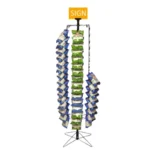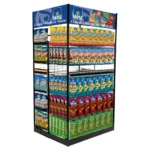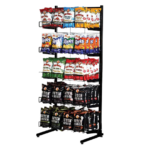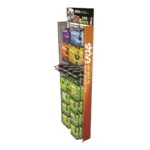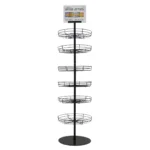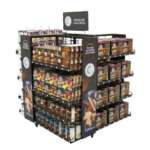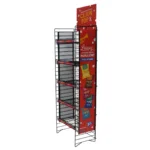The past 12 months have proven once again how merchandise displays have become more than just a means to showcase products.
Before we welcome 2025, let’s take one last look at the year that was for these powerful marketing tools that shape customer experiences and influence purchasing decisions.
Let’s review the insights of 2024 and be prepared for what the future holds for the dynamic retail display industry.
Key Directions Shaping the Industry
In 2024, the retail displays saw exciting trends that redefined how products are showcased:
- Sustainability was a major focus as retailers increasingly used eco-friendly materials to create both stylish and kind-to-the-planet structures.
- Technology integration also made a big splash, with features like interactive screens and augmented reality bringing 50% higher engagement.
- Personalization remained a strong trend, and consumers witnessed retailers customize their displays to reflect the unique preferences of individual shoppers.
While aesthetics continued to play a major role in the shifts and movements of the retail display industry, two other actors won title parts: reshaping customer interactions and setting new standards for shoppers’ expectations from their in-store experiences.
What’s Hot: Trends Expected to Thrive Through 2025
Green Initiatives
Sustainability remains at the forefront, with a growing number of retailers embracing earth-friendly materials and practices. This ongoing focus is not just about meeting regulatory requirements but also aligning with consumer values.
Today’s shoppers are more environmentally conscious than ever, and they prefer brands that demonstrate a genuine commitment to the planet’s wellbeing. A McKinsey study showed 6.4% five-year growth for products with environmental, social, and governance (ESG) related claims compared to 4.7% for those without.
Younger consumers are more inclined to stop purchasing from non-eco-conscious brands, with Gen Z leading at 31%. In response, 65% of brands have started using sustainable materials, while 62% used energy more efficiently.
Adopting Technology
Going digital is another trend that is set to persist. Advancements in augmented reality, virtual try-ons, and interactive touchpoints are transforming the retail space, making it more engaging and immersive. These technological features not only enhance the shopping journey but also provide valuable data that can help retailers better understand customer behaviors and preferences.
This is most evident in the cross-merchandising trend, where various complementary items in a product line or of a brand are placed in one display. Bundling them in ready-to-go gift packs and at discounted prices was also popular.
Customized Shopping Experiences
Shoppers appreciate displays tailored to their individual tastes and needs, and retailers are responding by creating more personalized spaces. This trend is being driven by sophisticated data analytics and artificial intelligence (AI), allowing for a deeper understanding of customer profiles and more targeted merchandising strategies.
Personalization has emerged as a major victory for the industry in 2024. Retailers have been able to create highly customized displays that resonate with individual shoppers. These personalized experiences have led to increased engagement, higher conversion rates, and a deeper connection between consumers and brands.
Minimalist and Clean Designs
Simple, clutter-free displays that highlight product features and benefits resonate well with modern consumers who prefer a streamlined, easy-to-navigate shopping environment. This trend is likely to maintain its appeal as it aligns with broader lifestyle movements toward simplicity and mindfulness.
These movements reflect a dynamic year for retail displays, showcasing the industry’s ability to innovate and adapt to changing consumer preferences.
What Experts Say: Fads to Skip in 2025
In the coming year, retailers are advised to move away from certain trends that may no longer serve their best interests, such as:
Overly Complex Displays
While intricate designs can be visually striking, they often overwhelm customers and make it difficult for them to focus on the products. Prioritizing simplicity and clarity will create a more inviting shopping experience.
Static Displays
As technology continues to advance, shoppers are increasingly drawn to interactive elements that make their retail exploration more engaging. Displays that fail to incorporate these components may struggle to capture the interest of today’s tech-savvy consumers.
Un-Sustainable Displays
With environmental awareness on the rise, shoppers are more likely to favor brands that demonstrate a commitment to earth-friendly practices. Ignoring this trend could potentially alienate a significant portion of your customer base — particularly those who factor in sustainability in their purchasing decisions.
On to 2025: Forecasts and Future Insights
As we look ahead to 2025, the retail display landscape is poised for further transformation, driven by both technological advancements and evolving consumer preferences. Here are some predictions from experts:
Artificial Intelligence and Machine Learning (AI/ML) Domination
Expect to see a heightened focus on creating immersive, multi-sensory shopping experiences. Innovations such as virtual reality showrooms and AI-driven personalization will enable retailers to offer highly tailored and engaging in-store experiences that mirror the convenience of online shopping.
By analyzing user data and behavior in real-time, these technologies can customize messages to target audiences. For instance, digital signage can adjust according to weather, traffic, and local events to remain relevant and engaging.
Touchless technology is also projected to grow significantly, driven by health and safety considerations. Features like gesture recognition, voice commands, and mobile integration will become commonplace in display add-ons. This evolution aims to meet the growing need for contact-free interactions.
Sustainable Strategies Emphasize Circular Design Principles
Retailers are likely to adopt modular displays that can be easily reconfigured or repurposed to minimize waste and extend the life cycle of materials. A 40% rise in demand for energy-efficient solutions is predicted, with solar power, LED displays, and automated power-saving modes used to reduce environmental footprint.
While ensuring impactful communication, these innovations will not only lower expenses but also align with increasing consumer expectations for green practices.
Omni-Channel Retailing Will Grow
Seamlessly integrating physical and digital touchpoints ensures that customers receive a consistent brand experience whether they’re shopping in-store or online. In 2025, this would mean investing in displays that not only attract attention but also provide valuable data insights to refine merchandising strategies.
Inclusivity as a Key Consideration
Displays designed to be accessible and appealing to a diverse range of shoppers resonate with the needs and values of modern consumers. Retailers will increasingly incorporate features such as adjustable heights, multilingual support, and intuitive navigation to cater to varied needs and preferences.
Additionally, compelling and future-ready displays will utilize dynamic visuals and interactive elements to engage shoppers of all ages and abilities, ensuring a welcoming environment for everyone.
Continuing with what worked and recognizing what did not will help retailers better prepare and adapt for the new year. The bottom line should always be ensuring they continue to meet customer needs while staying competitive in a rapidly changing retail landscape.


